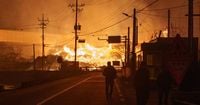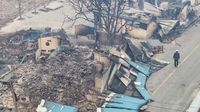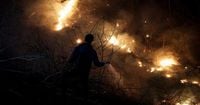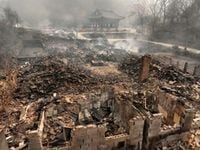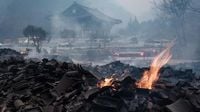At least 24 people have died and thousands have been forced to evacuate their homes due to a series of devastating wildfires in South Korea's southeastern region, described by the country’s acting president as the worst in its history. The fires, which ignited late last week, have prompted a national emergency response as they rapidly spread across the landscape, fueled by strong winds and dry conditions.
According to the Associated Press, the wildfires began on March 22, 2025, and quickly escalated, leading to the evacuation of approximately 27,000 residents. Fire officials reported that at least 26 individuals have sustained injuries as a result of the blazes, which have destroyed over 200 structures, including the historic Gounsa Temple, a 1,300-year-old Buddhist site.
In a televised address on March 26, acting President Han Duck-soo stated, "We are confronting the worst wildfires in our history using all available personnel and equipment, but the situation is not looking good." His comments reflect the urgency of the situation as firefighters struggle to contain the fires, which have burned approximately 17,000 hectares (42,000 acres) of land.
The majority of the fatalities occurred in Uiseong County, where 20 of the deceased were found. Four additional victims were reported from Sancheong County. Among those killed was a 73-year-old pilot who tragically died when his firefighting helicopter crashed in the mountains during rescue efforts. The cause of the crash is still under investigation, and the Korea Forest Service has temporarily grounded its firefighting helicopters.
Authorities have deployed around 5,000 firefighters and hundreds of helicopters to combat the flames, but efforts have been hampered by the ferocity of the winds and the dry weather conditions. As of Wednesday, the Uiseong fire was only 68% contained, with officials noting that the blazes were spreading at an unprecedented rate.
In addition to the loss of life, the wildfires have wreaked havoc on local infrastructure. Over 209 homes and buildings have been destroyed, including the Gounsa Temple, which was built in 618 during the Silla dynasty. National treasures housed within the temple have been relocated to safety, but the loss of such a historical site has been deeply felt by the community.
Local residents have described the chaos surrounding the evacuations. In the city of Andong, many evacuees reported fleeing their homes with little more than the clothes on their backs. Kwon So-han, a 79-year-old resident, recounted the harrowing experience: "The wind was so strong. I could only bring my body."
As the fires continued to rage, the South Korean government raised its crisis alert to the highest level, implementing emergency measures to protect residents and combat the fires. This included the transfer of inmates from nearby prisons to ensure their safety. The acting president emphasized the need for all available resources to be utilized in the firefighting efforts.
Experts have pointed to climate change as a contributing factor to the frequency and intensity of such wildfires. Yeh Sang-Wook, a professor of climatology at Hanyang University, noted that as atmospheric temperatures rise, the conditions for wildfires become more prevalent. He stated, "Wildfires will become more frequent. As the atmosphere becomes warmer due to climate change, the water vapor in the ground evaporates more easily, so the amount of moisture contained in the ground decreases."
The wildfires have also threatened several UNESCO World Heritage sites, including the historic Hahoe Folk Village and Byeongsan Seowon, both of which are located in Andong. Firefighters have been working diligently to protect these sites, with reports indicating that flames were only five kilometers away from Hahoe Village as of Wednesday.
In addition to the immediate damage, the wildfires have raised concerns about the long-term impact on the region's ecology and cultural heritage. The fires are already being characterized as the most devastating in South Korea's history, surpassing previous incidents in terms of both scale and destruction.
As the situation unfolds, the government has pledged to investigate the causes of the wildfires, which are believed to have originated from human activities, including careless use of fire while tending to family graves and agricultural operations. The rapid spread of the fires has been attributed to a combination of dry weather and strong winds, which have made it challenging for firefighting efforts to gain ground.
Looking ahead, the weather agency has forecasted some rain in the affected areas, but with only minimal amounts expected, the outlook remains uncertain. The government is urging residents to remain vigilant and prepared as firefighting efforts continue.
The wildfires in South Korea serve as a stark reminder of the increasing risks posed by climate change and the need for comprehensive strategies to prevent and respond to such natural disasters in the future.
